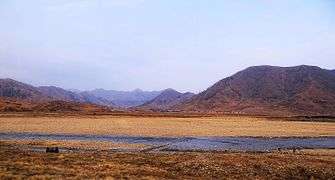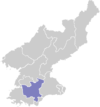North Hwanghae Province
| North Hwanghae Province 황해북도 | |
|---|---|
| Province | |
| Korean transcription(s) | |
| • Hangul | 황해북도 |
| • Hanja | 黃海北道 |
| • McCune‑Reischauer | Hwanghaebuk-to |
| • Revised Romanization | Hwanghaebuk-do |
 | |
| Country | North Korea |
| Region | Haeso |
| Capital | Sariwon |
| Subdivisions | 3 cities; 19 counties |
| Area | |
| • Total | 8,154 km2 (3,148 sq mi) |
| Population (2008) | |
| • Total | 2,113,672 |
| • Density | 260/km2 (670/sq mi) |
| Dialect | Hwanghae |
North Hwanghae Province (Hwanghaebuk-to) is a province of North Korea. The province was formed in 1954 when the former Hwanghae Province was split into North and South Hwanghae. The provincial capital is Sariwon. The province is bordered by Pyongyang and South Pyongan to the north, Kangwon to the east, Kaesong Industrial Region to the south, and South Hwanghae southwest. In 2003, Kaesong Directly Governed City (Kaesong Chikhalsi) became part of North Hwanghae.
Administrative divisions
North Hwanghae is divided into 3 cities ("si") and 19 counties ("kun"). Three of these counties (Chunghwa, Kangnam, and Sangwon) were added to the province in 2010 after being split from Pyongyang.[1]

Cities
Counties
Transportation
North Hwanghae is connected to the rest of the country (and allegedly to South Korea) by way of the Pyongbu Railway Line (known in South Korea as the Kyongui Line), which, in theory, runs from Pyongyang to Pusan; however, in reality, the line is cut short by the Korean Demilitarized Zone. It is also served by several large highways, most notably the Pyongyang-Kaesong Motorway.
Education
There are several higher-level educationary facilities in North Hwanghae, all government-run. These include the Kye Ung Sang Sariwon University of Agriculture, the Sariwon University of Geology, and the Sariwon Teachers University.
Culture
Historic landmarks
North Hwanghae has many historical relics as the site of the Koryo-dynasty capital at Kaesong, a depository for many famous historic relics. The province is also home to the tombs of many of the Koryo monarchs, the most famous being the tombs of kings Taejo and Kongmin, though others are spread throughout Kaesong and Kaepung county. Kaesong also houses the Koguryo-era Taehungsan Fortress, built to protect the kingdom's capital at Pyongyang and enclosing the famous Kwanum Temple. Nearby to Sariwin is the famous Jongbangsan Fortress, another Koguryo satellite for the defense of Pyongyang. This fortress encompasses the 9th-century Songbulsa Buddhist temple, one of the oldest and most picturesque in the country.
References
- ↑ "Pyongyang now more than one-third smaller; food shortage issues suspected", Asahi Shinbun, 2010-07-17, retrieved 2010-07-19
External links
- 행정 구역 현황 (Haengjeong Guyeok Hyeonhwang) (in Korean only)
- http://nk.joins.com/map/i223.htm
- http://www.kcna.co.jp/item/2006/200605/news05/11.htm
 |
Pyongyang | South Pyongan |  | |
| |
Kangwon-do | |||
| ||||
| | ||||
| South Hwanghae | Gyeonggi-do, |
